Texas Railroad History - Tower 90 - Victoria
Crossing of the Galveston, Harrisburg
& San Antonio (GH&SA) Railway and the St. Louis, Brownsville & Mexico (SLB&M) Railway
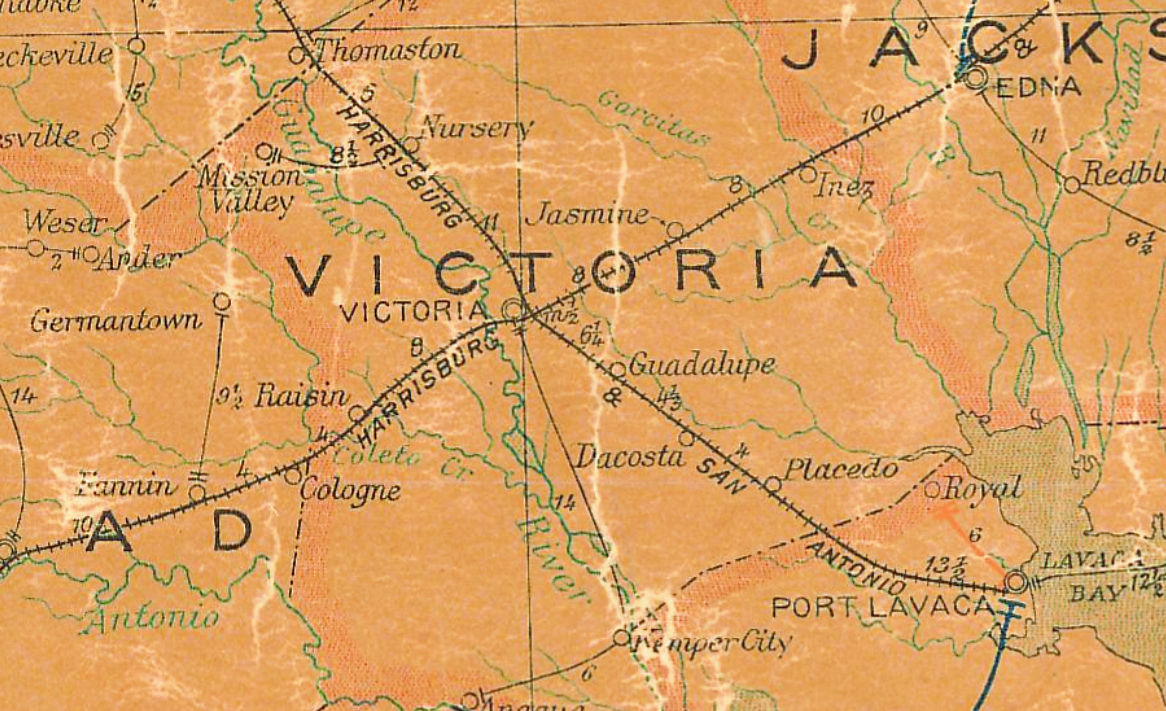 |
Left: This
1907 postal map (courtesy Texas General Land
Office) shows the basic 'X'-pattern of the Galveston, Harrisburg
& San Antonio (GH&SA) Railway at Victoria. The railroad heritage of the
four legs of the 'X' were...
Northwest
and Southwest
Gulf, Western Texas & Pacific
Northeast
New York, Texas & Mexico
Southeast
San Antonio & Mexican
Gulf
The GH&SA was leased by Southern Pacific (SP) in 1883 and
acquired several years later. The St.
Louis, Brownsville & Mexico Railway does not
appear on this map because it built to
Victoria from Bloomington a few years after
the map was drawn.
|
Victoria is one of the oldest towns in Texas and one of the earliest to
have rail service. The first to arrive was
the San Antonio and Mexican Gulf (SA&MG) Railroad. Its charter had been issued
ten years before the Civil War when citizens of Port Lavaca decided to grapple
with the difficulty of moving freight between their port and the population
centers further inland. With an immediate objective of reaching Victoria, the
first five miles out of Port Lavaca was completed c.1858. The
remaining 23 miles to Victoria was completed in 1861. The SA&MG did not survive the
War intact but it was rebuilt by the Federal government afterward. When the
construction debt owed to the government could not be repaid, the line went into
bankruptcy and was sold at auction to Charles Morgan in 1870.
Morgan was a shipping
magnate operating in the Gulf of Mexico looking for ways to
improve the movement of inland freight to and from the Gulf ports served by his
ships. In 1871, Morgan
renamed the SA&MG to become the Gulf, Western Texas and Pacific (GWT&P)
Railway. In 1873, Morgan extended the line from Victoria to Cuero, a total
of 56 miles from Port Lavaca. Near Houston, Morgan expanded his efforts to
improve port access by building his own port on Buffalo Bayou at
Clinton, east of Houston.
To this end, he organized Morgan's Louisiana and Texas Railroad and
Steamship Company and then bought the Houston & Texas Central (H&TC)
Railway in early 1877, naming his son-in-law, Charles Whitney, President.
The H&TC's main line ran from Houston north to
Denison at the Red River.
Morgan died in
1878, and the settlement of his vast estate resulted in Southern Pacific (SP) gaining control of the GWT&P in 1882, operating it as a wholly owned subsidiary. In 1889, SP funded a GWT&P extension from Victoria
southwest to Beeville, a
distance of 55 miles. In 1905, the GWT&P was formally integrated into the
Galveston, Harrisburg and San Antonio (GH&SA) Railway, SP's principal operating company in south Texas.
The GH&SA was subsequently leased (1927) and then merged (1934) into what
evolved to become SP's primary operating company in Texas
and Louisiana, the Texas & New Orleans (T&NO) Railroad.
In 1881,
the New York, Texas & Mexican (NYT&M) Railway was chartered as part of a grand
plan to build a railroad from New York City to Mexico City. The enterprise was
organized by Italian financier Count Joseph Telfener. Work
began in Texas with construction of a 91-mile line from Rosenberg through
Wharton to Victoria. It was completed in 1882,
mostly built by laborers brought in from Italy (and thus nicknamed the Macaroni
Line.) The NYT&M's plan was curtailed when the railroad was acquired by
SP in 1885, although it continued to operate under its own name. In 1905, SP fully merged
the NYT&M into the GH&SA. The small town of Telferner located on the
railroad eight miles northeast of Victoria is named for Count Telfener, but the
town's name was corrupted by Post Office officials. Newspapers of the era
confirm that Telfener was the correct spelling of the Count's last name
(or at least, all of the newspapers spelled it that way!)
New York to Mexico City? Grand plan?
That wouldn't qualify as a branch line for the next railroad in Victoria! In
1891, Victoria became the home and starting point of the Pan American Railway.
The railroad built south from Victoria, managing to lay ten miles of track to
the Guadalupe River before they ran out of funds. The city of Victoria refused
to pay any of the promised $150,000 bonus unless additional mileage was built.
The tracks were abandoned in 1894, undoubtedly disappointing the citizens of Pan
American's planned endpoint, Rio de Janeiro, Brazil.
It took nearly two decades after the failure of the Pan American Railway
for
the next railroad to reach Victoria. It was the St. Louis, Brownsville
and Mexico (SLB&M) Railway, the first of the Gulf Coast Lines (GCL),
the
marketing name for a syndicate backed financially by the St. Louis Trust
Company. The GCL was
the brainchild of Benjamin Franklin Yoakum, a native Texan with
significant experience in Texas railroading who had risen to become the Chairman of the St. Louis & San Francisco ("Frisco") Railway. His idea was to build
or buy Texas and Louisiana railroads to be weaved into a system to compete directly with SP
along the Gulf Coast between New Orleans and Houston.
The individual railroads would be managed cooperatively by Frisco executives
reporting to Yoakum.
Before Yoakum had even acquired the first GCL railroad, he
altered his strategy in the summer of 1902, making the decision to construct a
Brownsville - Houston line. The story broke
publicly in the Beeville Bee in early January,
1903 when it reported that Yoakum's recent travels to Brownsville and San
Antonio had pertained to "... a new railway project for Brownsville, with
the Frisco, of which Mr. Yoakum is president, behind it." Yoakum quickly
formed a syndicate with his circle of investors and they incorporated the SLB&M
corporation on January 12, 1903. The charter for the
SLB&M was granted by the Legislature and signed by Gov. Samuel T. Lanham on
June 6, 1903. Construction started at Robstown in
August;
materials could be shipped there from the Port of
Corpus Christi on the Texas Mexican (TM) Railway. The main line was
finished by 1906, south to Brownsville and north to Algoa where rights on the
Gulf, Colorado & Santa Fe Railway eventually provided a route
into Houston (the rights agreement with
Santa Fe was delayed for various reasons
until the spring of 1908.) The SLB&M built major stations at
Harlingen and Bay City,
and crossed the GH&SA's Port Lavaca line at
Placedo. It also served the Port of Corpus
Christi using trackage rights on the TM.
Long before Yoakum entered the picture, the idea of a Victoria - Port O'Connor rail line had been
promoted in the mid 1890s by T. M. O'Connor, a wealthy Victoria cattle
rancher. O'Connor owned 75,000 acres along the coast south of Indianola
and wanted to develop a hunting and fishing resort. Two attempts to lay
rails from Victoria to Port O'Connor had failed, but in 1909, Yoakum
agreed to have the SLB&M build the line in exchange for $70,000 to be
paid over ten years in equal installments. The Port O'Connor -
Bloomington segment opened in 1910. It would be extended
north to Victoria two years later.
Right:
The Hallettsville New Era of
February 9, 1912 quoted the Victoria
Advocate noting the imminent start of work on the SLB&M
extension from Bloomington to Victoria. The engineer for the project,
Louis A. Gueringer, had long been Yoakum's Chief Engineer for the GCL and he later
became Chief Engineer for the Railroad Commission of Texas (RCT). The
article mentions a planned extension to the town of Yoakum, but it was never built. |
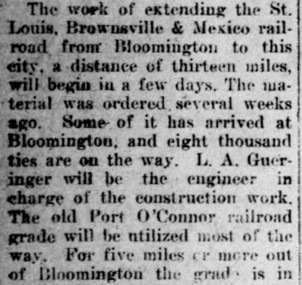 |
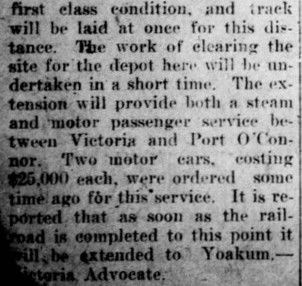 |
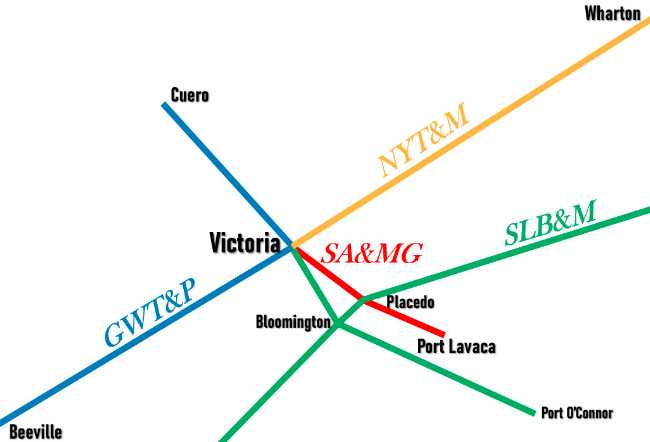

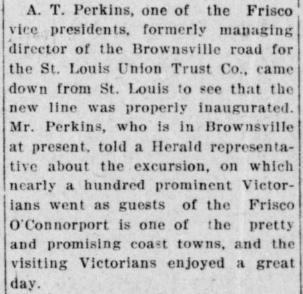
Above Left: On this
rail map of the Victoria area c.1913 (not all railroads shown) all of the routes
except the SLB&M lines were owned by the GH&SA. Above
Center and
Right: The Brownsville Herald
of May 2, 1912 reported on the VIP excursion from Victoria to Port
O'Connor that celebrated the opening of the new line. As the headline shows, by
this time all GCL
activity was attributed to the Frisco. Significantly, B. F. Yoakum is not
mentioned attending the celebration. He was no longer the Frisco CEO, having
relocated to New York where he later became a mortgage banker.
Victoria was an important population center and an
endpoint for the SLB&M; the tracks from Bloomington did not proceed beyond
Victoria. Frisco management
anticipated significant traffic there, so a major yard with passenger and freight depots
was built along the west edge of downtown, about two miles west of where the
SLB&M crossed the GH&SA line to Beeville and a quarter mile west of the
Victoria County
courthouse. The railroads built a manned interlocking tower at their crossing,
and it was commissioned as Tower 90 by RCT on January 3, 1913 with a 12-function
mechanical plant. This was likely a typical minimal interlocker for a crossing
that had no connecting tracks. The twelve functions would be a home signal, a
distant signal and a derail in each of the four directions. The 1917 Sanborn Fire Insurance map
of Victoria shows the tower to be a two-story structure, but no photos of this
tower have been located.
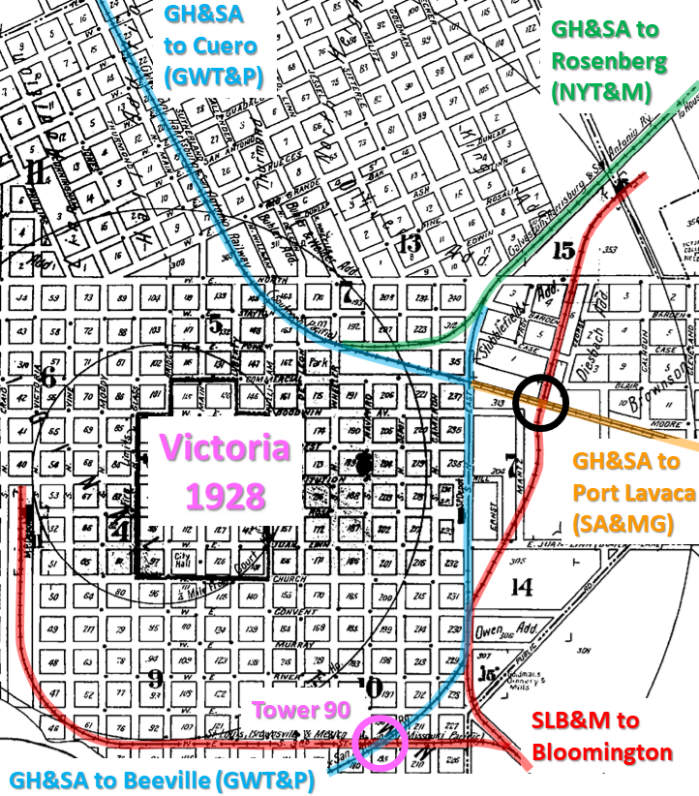 |
Left:
The railroads in Victoria are highlighted on this Sanborn Fire
Insurance index map from January, 1928. The map shows that the SLB&M
tracks ended along the west side of Victoria less than two miles west of
Tower 90.
Below: With north
to the right, the foundation remnants of the passenger depot
on the west side of Victoria were still
intact when Google Earth captured this satellite image in January, 2017.
The depot and adjacent yard were abandoned in the 1970s and the land
remains undeveloped. The GCL had become fully independent of the Frisco
by 1915. Missouri Pacific (MP) then bought all of the GCL
railroads in 1925. They became fully merged into MP in 1956. MP was
acquired by Union Pacific (UP) in 1982.
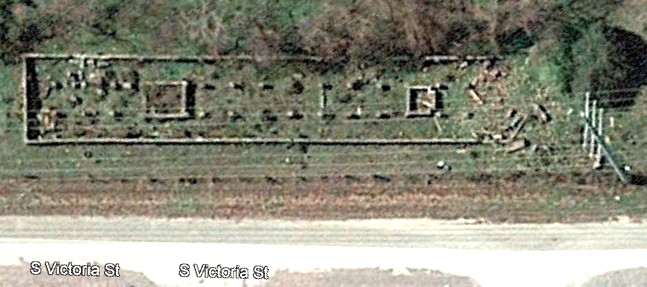
A 1938 T&NO
Employee Timetable (ETT) shows Tower 90 located on the Beeville
Subdivision, staffed from
7:30a to 4:30p daily except Sunday and legal holidays. It also shows
that there was one whistle code for the Tower 90 operators ...

... which
seems odd for a tower with no connecting tracks. Perhaps it
was used to signal readiness to exit a nearby siding.
A 1947
T&NO ETT shows that the hours had shifted slightly to be 8:00a to
5:00p and noted that when the operator was not on
duty, the signals would be set to allow movements on the T&NO tracks.
A
1949 T&NO ETT lists Tower 90 as an automatic
interlocker. It is unlikely that the tower building survived much beyond
this timeframe since the automatic plant
could be housed in a trackside cabinet.
The other SLB&M / GH&SA crossing (black circle on the map) was not interlocked and
was within Yard Limits, handled by special rules. |
|
The SLB&M line from Bloomington in 1912 had the distinction of being the
last railroad into Victoria ... until it wasn't! In the early 1990s, SP decided
that it no longer needed the line between Victoria and Rosenberg. The line's
dismantling began when the tracks between Victoria and Wharton were abandoned in
1993. An additional 23 miles beyond Wharton was formally abandoned in 1995, and
the remainder of the line to Rosenberg was out of service. As a result of SP's
merger with UP in 1996, Kansas City Southern (KCS) Railway was allowed to purchase the
dormant right-of-way (ROW) between Rosenberg and Victoria. Prior to the
purchase, KCS had acquired 49% of the TM, and it used the TM to buy the ROW. The TM had tracks
from Laredo to Robstown, and KCS had rights on UP's lines between Robstown and
Beaumont, where KCS has a main line that goes north to Kansas City. Although
landowners along the former SP ROW filed suit, KCS eventually won and
was allowed to rebuild the line between Victoria and Rosenberg, thus becoming
yet another railroad to build into Victoria, albeit on an existing, abandoned
ROW. The new line shortened KCS' route between Beaumont and Robstown by 70 miles
and reduced by 160 miles the UP trackage over which KCS needed to operate. KCS
commenced service on their new line in 2009. In 2023, KCS merged with Canadian
Pacific, the new company being named CPKC.
SP abandoned the last thirty-eight miles of the line
into Beeville in 1979. The tracks from Victoria to Fannin remain in service, supporting coal deliveries to
the Coleto Creek Power Plant and servicing a large VLS Environmental Solutions
railcar repair facility. The power plant is scheduled to close in 2027, but the
plant's owner has announced plans to re-power it using natural gas delivered by
pipeline. The other SP lines out of Victoria, north to Cuero and south to Port
Lavaca, remain in service. The line to Port Lavaca is used by CPKC for its Robstown trains via Placedo. The former SLB&M
line to Bloomington remains intact now owned by UP, but the tracks to the west
side yard and depot that crossed at Tower 90 have long been abandoned.
 |
Left: The January,
1928 Sanborn Fire Insurance map of Victoria shows Tower 90 ("R R Signal
Tower") as a two-story structure located on East South 3rd. between S.
Navarro and S. Depot.
Below:
Magnification shows the tower sitting parallel to the GH&SA tracks with
the door on the north corner of the east side of the tower.

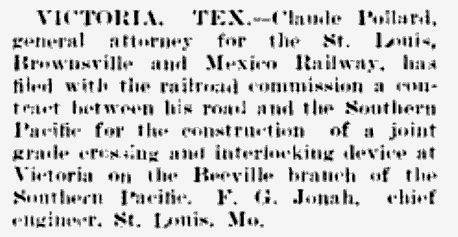
Above: This news
item in the July 7, 1912 edition of
Southern Hardware Tradesman announced that SP and the SLB&M
had filed a contract with RCT to build a grade crossing and interlocking
to permit the SLB&M to cross SP's Beeville Branch at Victoria. Tower
90 was commissioned by RCT six months later. |
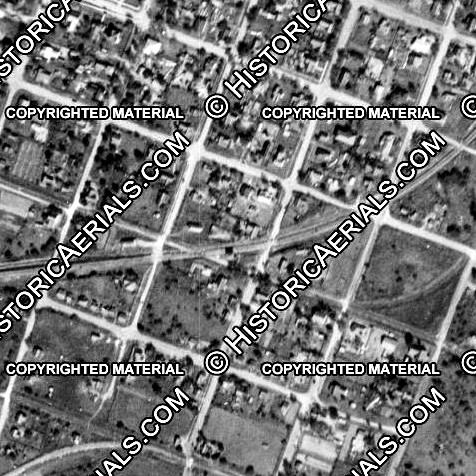 |
(all images (c) historicaerials.com)
Left: This 1929 aerial image shows the Tower 90
crossing near the center. The small black square is the shadow of the
tower cast to the north across the SP tracks. See magnification
below.

Right: This 1958 image shows the equipment
cabinet for the Tower 90 automatic plant as a small white rectangle
where the tower had been located. |
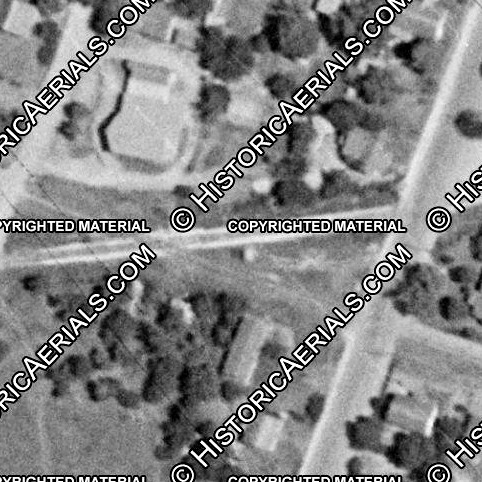 |
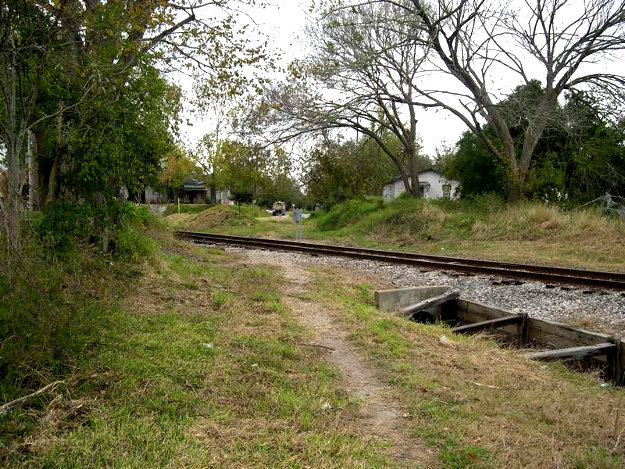
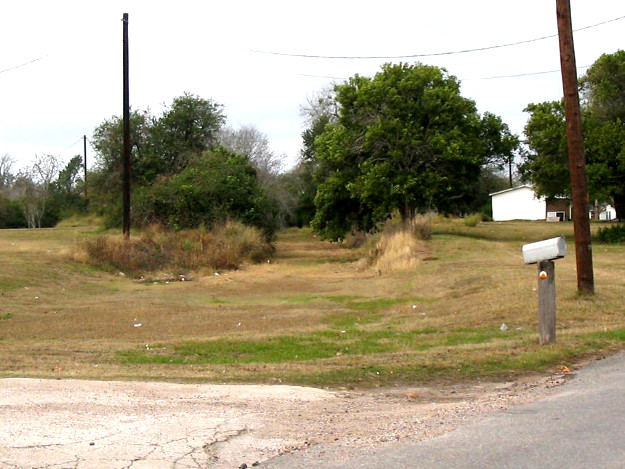
Above Left:
This is a view looking east toward the site of Tower 90 along unpaved 3rd St.,
the former SLB&M right-of-way.
Comparing this view to the Sanborn map, Tower 90 should have been located at the
mound of dirt to the left of and just beyond the SP tracks. (Carl Codney photo,
2003) Above Right: The swale of the
former SLB&M right-of-way is easily spotted where the branch to MP's yard
and depot joined the
main line to Bloomington southeast of Tower 90. (Jim King photo, Dec. 2006)
Personal Observations of Roy Ekstrum (8/26/2005)
I've lived in Victoria all my 52 years and my home is about 6 blocks from where
Tower 90 was. My grandfather worked the Victoria to Alice train up til the
day he died in 1943. I've visited the actual location of 90 many times looking
for leftovers but they are pretty slim. Bases of the distance signals are still
in place on the south end on the SP and on the west end on the ROW of the MP.
The MP track was pulled up in the mid 80s I think, I really don't remember when
it was but do remember the track crossing Moody St. by the river bridge, and I
do remember the tracks in the MP yard in the early 70s. I've never seen a photo
of tower 90... I have no idea what it looked like, I think either the
Frisco or the SLB&M built it and maintained it... There was a second interlocker
in Victoria but it was just a blockhouse, was removed several years ago... It
was where the main crossed the line running from Port Lavaca going to Cuero.
Another crossing was about 0.1 mi toward Port Lavaca from the Houston/CC line.
That is where the MP crossed going to the cotton compress. Both of these were
controlled by the station about 6 blocks down the street, I think. That MP
crossing I don't think even had a signal with it. And at one time another
interlocker was planned for the line that ran to Port O Connor and was to cross
near the old compress. That line was to run to Yoakum but was never built out to
Yoakum. The POC to Victoria part was built but was relined to come in to
Victoria and crossed the SP at Tower 90.
Roy's comment regarding which railroad built and
maintained the tower raises an interesting question. Since the crossing did
not exist prior to 1901 when RCT gained
authority to regulate the mode and manner of grade crossing safety, RCT's rule
specified that the second railroad at a crossing (i.e. the one that created it)
was responsible for the capital outlay for the tower and associated interlocking
system. (Capital expenses would be split evenly for crossings that existed
before 1901.) Thus, the SLB&M would have paid for design, construction and
installation of Tower 90 and its equipment since the crossing did not exist
until c.1912. By rule, the recurring cost for tower operations and maintenance
(O&M) was always split between the railroads since both railroads benefitted
from a tower's operations. The railroads would agree on which one of them would
take the lead for O&M staffing, and that railroad would bill the other on a
periodic basis using an agreed sharing ratio (typically the percentage of total
interlocking functions assigned to each railroad -- here, it was very likely 50
/ 50 -- and the ratio would be updated as interlocking functions changed over
time.) In 1916, RCT began identifying the railroad responsible for O&M at each
tower, and for Tower 90, it was the GH&SA (and this remained unchanged through
1930; RCT provided no information beyond that year.) The GH&SA taking the lead
is surprising because in most cases, the company with O&M
responsibility for a tower was usually the one that had designed and
built it (but there were exceptions, e.g. Tower 8.)
And typically, the company that paid the entire capital outlay for a
tower at a post-1901 crossing would take the lead in designing and building it
(but there were exceptions, e.g. Tower 6.) For
Tower 90, a good guess would be that the SLB&M paid SP (GH&SA) to design and
build the tower since GH&SA ended up with the responsbility for O&M staffing.
Personal Observations of Leonard Ruback (8/31/2005)
I did not frequent that part of town in the timeframe given (too young plus the
area is a bit ...uh... rough). The GH&SA line is still there and hosts
coal trains to Fannin (Coleto Creek). The MP line is long
gone. I do remember the MP line crossing the highway just before the
Guadalupe River bridge. I never saw a train on it though. Today the
old MP roadbed is a street. Back when I explored the area, the old grade
was a gravel street. I do not think you could find any evidence of a rail
line ever being there today. The MP also crossed the river down by the power plant. The line served numerous aggregate pits south of town.
Today the area is a city park / lake. There is some evidence of this left
if you know where to look. There used to be a horrendous curve on the MP line
right at the Water St. crossing. The MP also served a large cotton
compress which was located right next to the SP yard and north of North St.
I do remember this line crossing North St and running through people's back
yards. Never
saw a train on it though and it was probably abandoned from north of Port Lavaca
Drive when I was young.
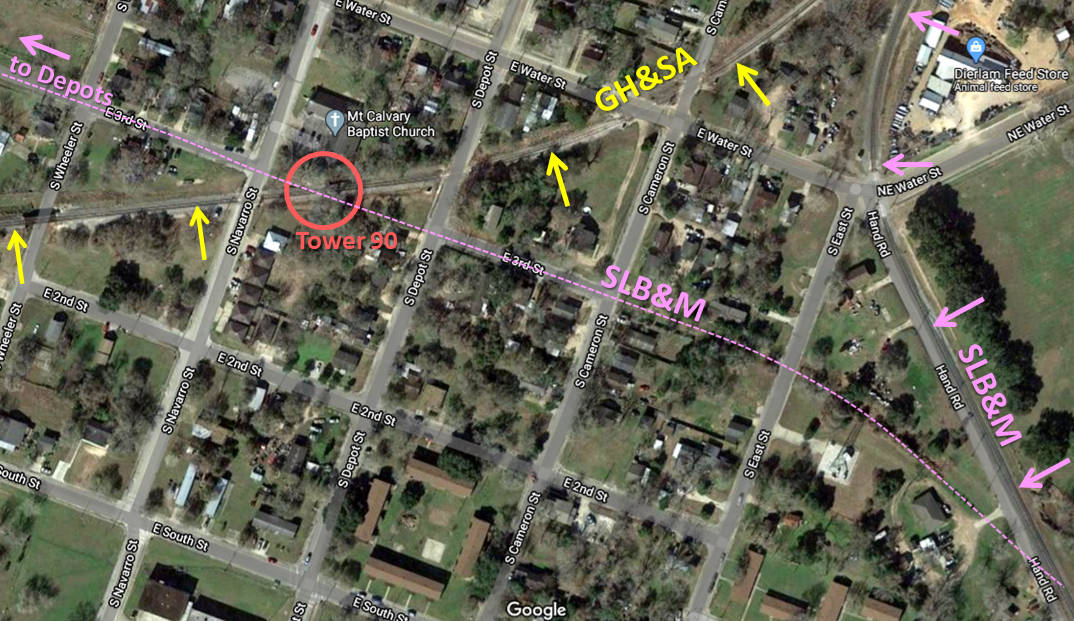 |
Left: This
annotated aerial image of Victoria from January 21, 2017 shows that the
SLB&M tracks ran down what is now E. 3rd St. The block
distances to E. 2nd St. and E Water St. suggest that E. 3rd St. had been
platted and may have been a gravel roadway prior to the City of Victoria granting an easement to the SLB&M. The SLB&M's arrival into
Victoria was some thirty years after the other railroads in town, hence
urban development made finding a right-of-way into downtown impossible
without assistance from the City. Victoria's agreement with the SLB&M
required the City to provide a free right-of-way through town and free
land for SLB&M's yard and depots. The only land available was west
of downtown near the Guadalupe River. (Google Earth image) |
Right:
SP's depot at Victoria (Joe Dale Morris collection, 1951) was located
east of downtown along the main line to Rosenberg (northeast) and
Beeville (southwest.) It was the site where the NYT&M had originally
built its depot and offices. A historical marker erected at the site by
the Texas Historical Commission explains...
"... Southern Pacific built a depot at this
site in 1888-89 to serve arriving and departing passengers and to house
its headquarters. Later, Victoria served as division headquarters for
the Galveston, Harrisburg & San Antonio Railroad. The two-story depot
had a baggage room, waiting rooms and ticket offices on the first floor,
with the division's general offices and the dispatcher on the second
floor. It often served as a gathering place for community social
functions. The last passenger train left Victoria in 1953, but the depot
remained in use for various purposes until 1979."
The
depot burned in 1984. |
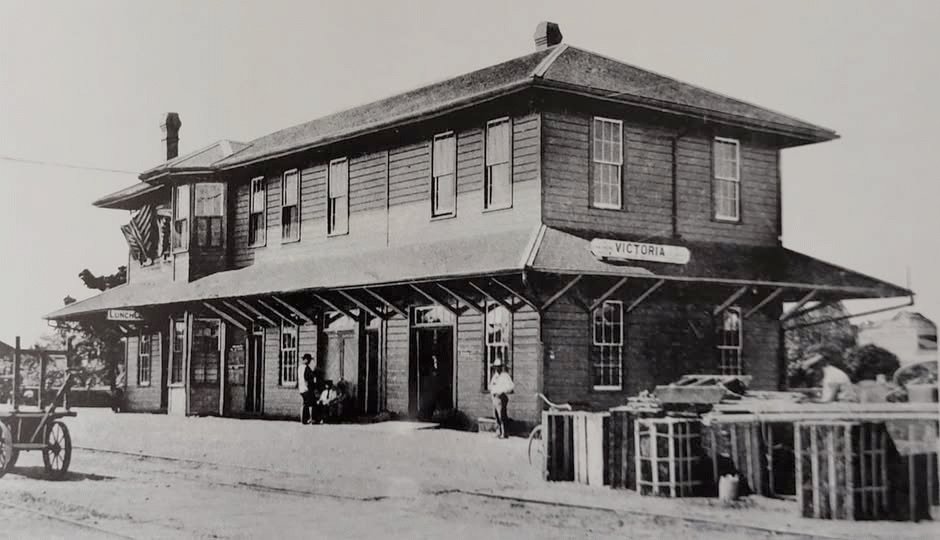 |

Last Revised: 12/15/2025 JGK - Contact
the Texas Interlocking
Towers Website

















